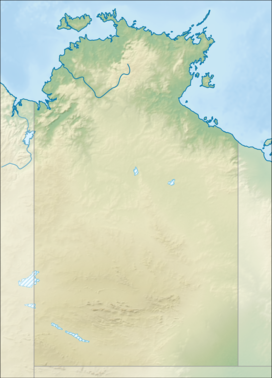Mount Conner
| Mount Conner | |
|---|---|

Mount Conner seen from the road to Uluru
|
|
| Highest point | |
| Elevation | 859 m (2,818 ft) AHD |
| Coordinates | 25°29′49″S 131°54′00″E / 25.497°S 131.900°ECoordinates: 25°29′49″S 131°54′00″E / 25.497°S 131.900°E |
| Naming | |
| Etymology | M. L. Conner |
| Geography | |
| Location | Northern Territory, Australia |
Mount Conner, also known as Attila and Artilla, and occasionally found as Mount Connor, is an Australian mountain located in the southwest corner of the Northern Territory, 75 kilometres (47 mi) southeast of Lake Amadeus at the border of the vast Curtin Springs cattle station in Pitjantjatjara country. It reaches to 859 metres (2,818 ft) above sea level and to 300 metres (984 ft) above ground level.
Mount Conner is a flat-topped and horseshoe-shaped inselberg/mesa, part of the same vast rocky substrate thought to be beneath Uluru/Ayers Rock and Kata Tjuta/Olgas. It can easily be confused with Uluru, since it can be seen from the road to Uluru and Kata Tjuta, when approaching from Alice Springs. It was named Mount Conner by William Gosse in 1873 after South Australian politician M. L. Conner.
Attila is close to the site of Kungkarangkalpa, the Seven Sisters Dreaming.
Mt Conner consists of conglomerates, sandstones, siltstones, and mudstones of the Late Ediacaran–Early Cambrian Winnall beds and the Middle Cryogenian–early/mid Ediacaran Inindia beds. The Winnall beds form the upper part of Mt Conner. The summit consists of grey to coarse-grained sandstone with pebble layers and minor beds of pebble conglomerate and siltstone that form a prominent scarp. The Winnall beds that underlie this scarp is a recessive unit composed of dark brown micaceous siltstone, mudstone, and fine-grained sandstone. The lower part of Mt. Conner consists of planar and trough cross-bedded, medium to coarse-grained, grey-brown sandstones, dark brown siltstones, and cherts, of the Inindia beds. The upper part of the Inindia beds are fluvial deposits. The sides of Mt Conner are also blanketed by scree (talus) and its top is blanketed by colluvium. The base of Mt Conner is surrounded by alluvium.
...
Wikipedia

